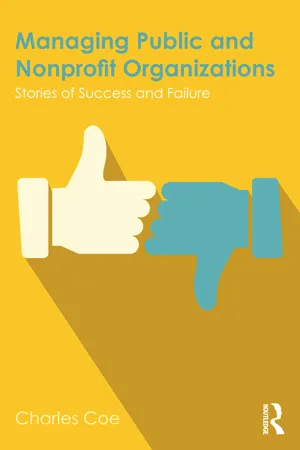
- 168 pages
- English
- ePUB (mobile friendly)
- Available on iOS & Android
About this book
Managing Public and Nonprofit Organizations approaches public management learning in a unique way, examining more than 100 high-profile and little-known administrative failure and success stories to explore how failures happen, how they can be prevented, and how to replicate successes in other jurisdictions. Organized to complement a standard public management or organizational behavior textbook structure, and to satisfy NASPAA accreditation requirements, this book explores both traditional public administration functions (performance management, financial management, human-resource management, procurement management, policymaking, capital management, and information-technology management) and organizational concepts (organizational structure and organizational culture). Unlike a traditional casebook, the accompanying stories do not stop in the middle to ask the readers what they would do; instead readers are asked to consider how the events illuminate what public management means and how to make it most effective. The stories ground and give meaning to the book's review of principles and best practices.
Stories include both well-known and highly reported stories of success and failure including Wikileaks, the Boston Marathon bombing, bankruptcy of Detroit, British Petroleum oil spill, 9/11 World Trade Center attack, decision to invade Iraq, Affordable Care Act website rollout, "Bridgegate" scandal, and the Brooklyn Navy Yard killings. The stories do not pass judgment on governments and nonprofits as institutions, but rather teach students and practitioners best management practices by example. Discussion questions are included at the end of each chapter to prompt classroom discussion.
Frequently asked questions
- Essential is ideal for learners and professionals who enjoy exploring a wide range of subjects. Access the Essential Library with 800,000+ trusted titles and best-sellers across business, personal growth, and the humanities. Includes unlimited reading time and Standard Read Aloud voice.
- Complete: Perfect for advanced learners and researchers needing full, unrestricted access. Unlock 1.4M+ books across hundreds of subjects, including academic and specialized titles. The Complete Plan also includes advanced features like Premium Read Aloud and Research Assistant.
Please note we cannot support devices running on iOS 13 and Android 7 or earlier. Learn more about using the app.
Information
1 Introduction
Methodology
Table of contents
- Cover
- Half Title
- Title Page
- Copyright Page
- Dedication
- Table of Contents
- Preface
- 1 Introduction
- 2 Organizational Structure
- 3 Organizational Culture
- 4 Performance Management
- 5 Financial Management
- 6 Human-Resource Management
- 7 Procurement Management
- 8 Policymaking
- 9 Capital Management
- 10 Information-Technology (IT) Management
- Appendix A: Meeting the NASPAA Universal Competencies
- Index